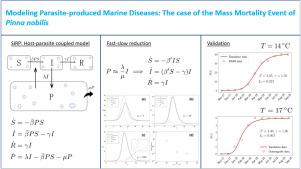Ecological Modelling ( IF 2.6 ) Pub Date : 2021-09-09 , DOI: 10.1016/j.ecolmodel.2021.109705 Àlex Giménez-Romero 1 , Amalia Grau 2, 3 , Iris E. Hendriks 4 , Manuel A. Matias 1

|
The state of the art of epidemic modelling in terrestrial ecosystems is the compartmental SIR model and its extensions from the now classical work of Kermack–Mackendrick. In contrast, epidemic modelling of marine ecosystems is a bit behind, and compartmental models have been introduced only recently. One of the reasons is that many epidemic processes in terrestrial ecosystems can be described through a contact process, while modelling marine epidemics is more subtle in many cases. Here we present a model describing disease outbreaks caused by parasites in bivalve populations. The SIRP model is a multicompartmental model with four compartments, three of which describe the different states of the host, susceptible (i.e. healthy), S, infected, I, and removed (dead), R, and one compartment for the parasite in the marine medium, P, written as a 4-dimensional dynamical system. Even if this is the simplest model one can write to describe this system, it is still too complicated for both direct analytical manipulation and direct comparison with experimental observations, as it depends on four parameters to be fitted. We show that it is possible to simplify the model, including a reduction to the standard SIR model if the parameters fulfil certain conditions. The model is validated with available data for the recent Mass Mortality Event of the noble pen shell Pinna nobilis, a disease caused by the parasite Haplosporidium pinnae, showing that the reduced SIR model is able to fit the data. So, we show that a model in which the species that suffers the epidemics (host) cannot move, and contagion occurs through parasites, can be reduced to the standard SIR model that represents epidemic transmission between mobile hosts. The fit indicates that the assumptions made to simplify the model are reasonable in practice, although it leads to an indeterminacy in three of the original parameters. This opens the possibility of performing direct experiments to be able to solve this question.
中文翻译:

模拟寄生虫引起的海洋疾病:以 Pinna nobilis 大规模死亡事件为例
陆地生态系统中流行病建模的最新技术是隔室 SIR 模型及其对 Kermack-Mackendrick 现在经典作品的扩展。相比之下,海洋生态系统的流行模型有点落后,并且最近才引入了分区模型。原因之一是陆地生态系统中的许多流行病过程可以通过接触过程来描述,而对海洋流行病的建模在许多情况下更为微妙。在这里,我们提出了一个模型,描述了由双壳类动物种群中的寄生虫引起的疾病爆发。SIRP 模型是一个多隔室模型,有四个隔室,其中三个隔室描述宿主的不同状态,易感(即健康)、S、感染、I 和移除(死亡)、R,一个隔室用于描述宿主中的寄生虫。海洋介质,P,写成一个 4 维动力系统。即使这是可以用来描述这个系统的最简单的模型,但对于直接分析操作和与实验观察的直接比较来说,它仍然太复杂,因为它取决于要拟合的四个参数。我们表明,如果参数满足某些条件,则可以简化模型,包括简化为标准 SIR 模型。该模型已使用最近发生的贵族笔壳大规模死亡事件的可用数据进行验证 如果参数满足某些条件,则包括对标准 SIR 模型的简化。该模型已使用最近发生的贵族笔壳大规模死亡事件的可用数据进行验证 如果参数满足某些条件,则包括对标准 SIR 模型的简化。该模型已使用最近发生的贵族笔壳大规模死亡事件的可用数据进行验证Pinna nobilis是一种由寄生虫Haplosporidium pinnae引起的疾病,表明简化的 SIR 模型能够拟合数据。因此,我们展示了一个模型,其中遭受流行病的物种(宿主)不能移动,并且通过寄生虫发生传染,可以简化为代表移动宿主之间流行病传播的标准 SIR 模型。拟合表明为简化模型所做的假设在实践中是合理的,尽管它导致三个原始参数的不确定性。这开启了进行直接实验以解决这个问题的可能性。











































 京公网安备 11010802027423号
京公网安备 11010802027423号